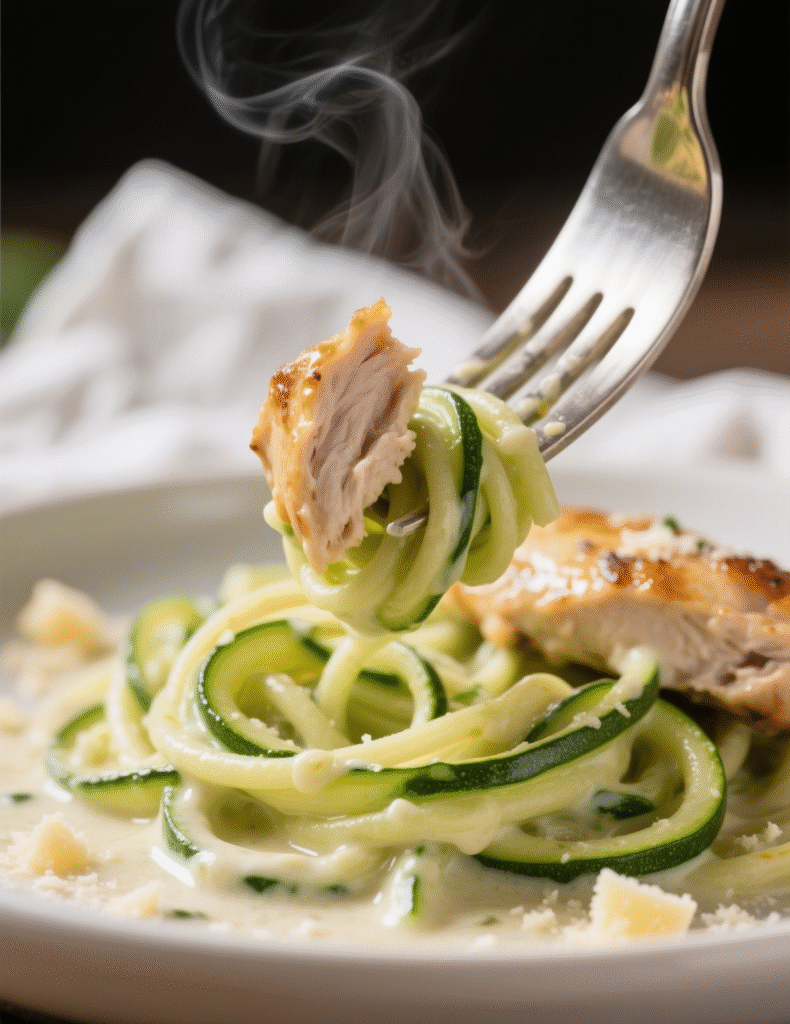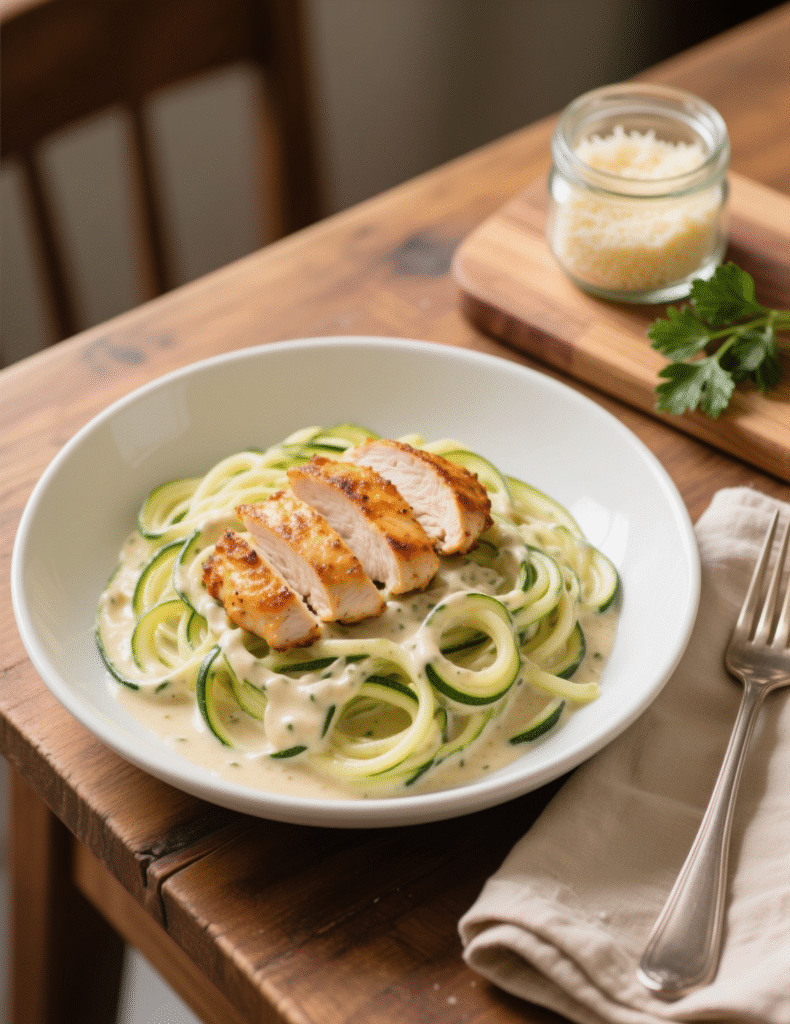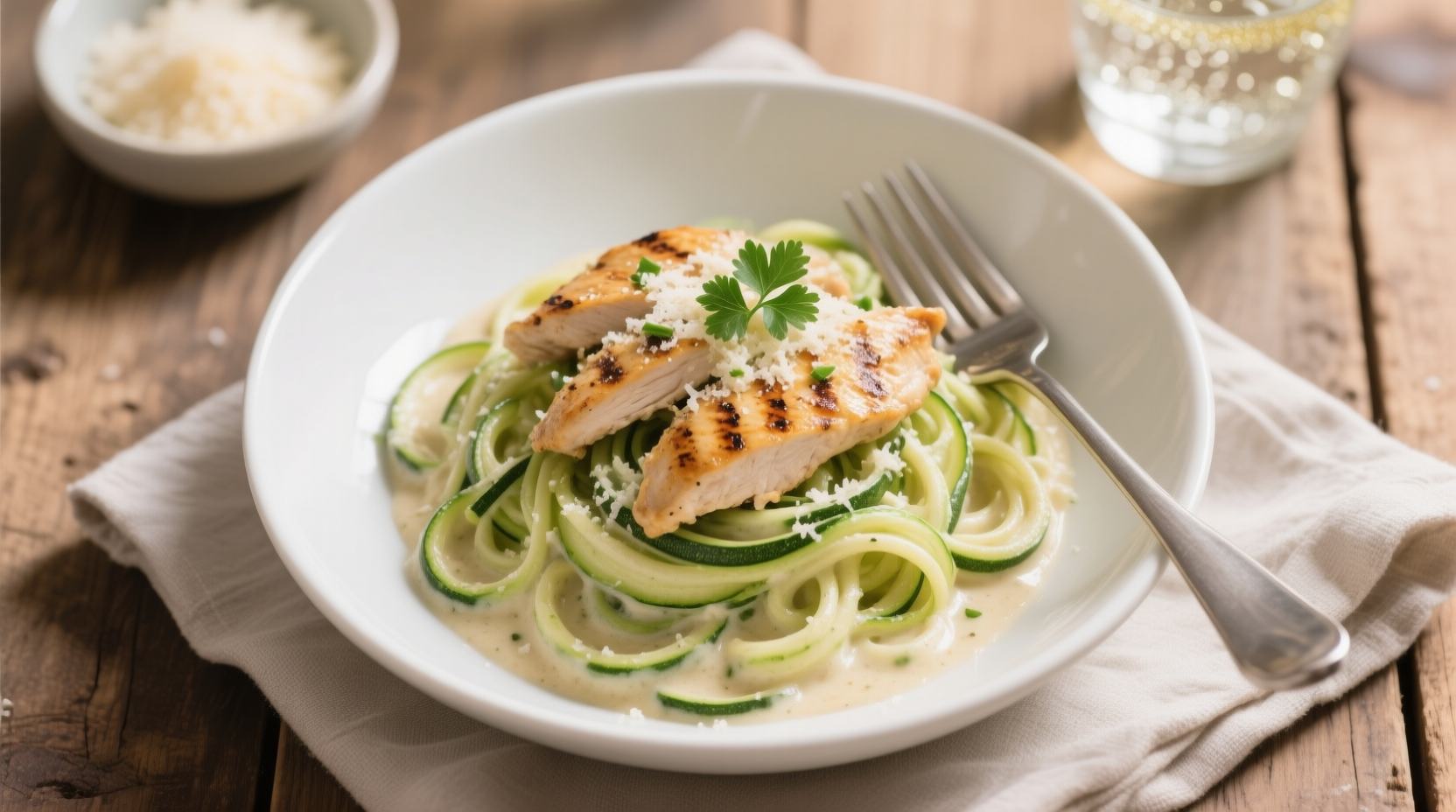Cooking is funny sometimes. A dish walks into the kitchen, looks traditional enough, and then one small shift changes everything. That’s what happens when you swap out pasta for zucchini noodles in a chicken Alfredo. You’re not just cooking dinner—you’re rewriting how comfort food can feel on a plate. This isn’t just about health swaps; it’s about technique, texture, and a chef’s ability to adapt classics to modern appetites.
Why Zucchini Noodles Matter More Than You Think
Zoodles, as people love to call them, are not a gimmick. They’re a legitimate pasta alternative when treated correctly. But too often, they get abused—left soggy, under-seasoned, or drowning in sauce. The truth is zucchini holds around 94% water, which means you’re not cooking a noodle, you’re coaxing water out of a vegetable and shaping it into a noodle’s role. If a cook doesn’t handle that water, the Alfredo becomes a puddle of diluted cream. That’s not Alfredo. That’s regret in a bowl.
Professionals know that you salt zucchini noodles lightly, let them sit, then pat dry. Some chefs even give them a quick sauté without sauce to drive off moisture. That’s what separates a dish that looks Instagram-worthy from one that actually tastes worth eating.
Chicken: Not Just Protein, but Balance
The chicken in Chicken Alfredo is often misunderstood. People think of it as the star. In reality, it’s the grounding force against the richness of cream and cheese. If you cook the chicken poorly—dry breast meat, rubbery texture—the dish collapses.
I prefer chicken thighs when I’m not strictly traditional, but most kitchens go with boneless skinless breasts. The trick is high-heat searing for color, then finishing low to keep the flesh moist. A touch of paprika or garlic powder isn’t cheating, it’s intelligent layering. Professionals don’t just cook meat; they coach it into playing well with sauce.
Alfredo Sauce: The Weight of Tradition vs. The Pull of Innovation
The original Alfredo wasn’t even creamy. It was butter, Parmesan, pasta water. That’s it. Italian immigrants in the US transformed it into the heavy cream-based version we know. So when you cook Alfredo today, you’re actually straddling two worlds: tradition and adaptation.
With zucchini noodles, cream sauce must be managed differently. Cream can overpower the delicate zucchini flavor. Parmesan has to be sharp enough to cut through creaminess, but not so strong it masks the vegetable. A 24-month aged Parmigiano-Reggiano works beautifully. For richness, a dash of mascarpone can round the sauce without heaviness. And no—never drown zucchini noodles. You coat them. Like painting a canvas, not flooding it.

Technique Over Ingredients
Here’s where chefs often trip. They buy spiralized zucchini, toss it in cream, add chicken, and call it a day. That’s lazy cooking. Precision comes from sequence. First, handle zucchini water. Then, sear chicken with proper Maillard reaction. Next, reduce cream with garlic and butter until it coats the back of a spoon. Only at the very end do noodles kiss the sauce.
This order ensures sauce clings instead of sliding off. It keeps textures distinct: tender chicken, creamy sauce, slightly firm noodles. Without sequence, you get mush and sadness.
Nutrition: The Numbers Speak
A single serving of traditional fettuccine Alfredo often climbs above 1,200 calories, with 75 grams of fat. Swap in zucchini noodles, and you can cut calories almost in half. One medium zucchini has about 33 calories, compared to nearly 200 for the same weight in pasta. That’s not just a diet trick—it’s a real impact for professional kitchens responding to customer demands for lighter menus.
Restaurants across the US report a 27% rise in “low-carb substitutions” requests in the last five years. Zucchini noodles aren’t a fad; they’re part of that demand curve. And chefs who ignore it will watch customers walk down the street to the competitor who doesn’t.
A Professional’s Step-by-Step: Zucchini Noodle Chicken Alfredo
Ingredients (4 servings):
- 4 medium zucchinis, spiralized
- 2 chicken breasts (or thighs if preferred), boneless, skinless
- 2 tbsp olive oil
- 3 tbsp unsalted butter
- 3 cloves garlic, minced
- 1 cup heavy cream
- ¾ cup freshly grated Parmesan (24-month aged if possible)
- 2 tbsp mascarpone (optional, but worth it)
- Salt & cracked black pepper to taste
- Fresh parsley for garnish
Method:
- Salt zucchini noodles lightly. Let them rest 15 minutes. Pat dry.
- Heat oil in a pan. Sear chicken until golden, finish cooking gently. Slice.
- In another pan, melt butter, sauté garlic. Pour in cream, simmer until reduced slightly.
- Whisk in Parmesan, then mascarpone if using. Season. Sauce should coat spoon evenly.
- Toss zucchini noodles briefly in sauce, just enough to warm.
- Plate noodles, top with sliced chicken, finish with parsley.
That’s it, but the difference lies in control. Control of heat, water, and balance.
Common Mistakes Even Pros Make
One: overcooking zucchini until it collapses into mush. Zoodles need a quick touch, not a long simmer.
Two: dumping sauce without tasting balance. Parmesan varies in saltiness, so always taste before final seasoning.
Three: ignoring presentation. A pile of zoodles can look messy. Twirl them neatly with tongs, place chicken angled, garnish with a whisper of parsley. Visual balance matters as much as flavor in a professional kitchen.

Variations That Work
Add roasted cherry tomatoes for acidity. Swap cream with cashew cream for a vegan angle (yes, vegan Alfredo can work if done right). Try smoked chicken for depth, or even shrimp for a lighter, oceanic profile. Professionals push a recipe past the obvious.
The Question of Trends
Zoodles sit at the intersection of health trends and culinary creativity. Keto dieters love them. Gluten-free eaters need them. But beyond dietary preferences, they reflect a broader movement: vegetables as centerpieces, not side notes. In 2024, the National Restaurant Association listed “plant-forward innovation” in its top 5 culinary trends. Zoodles fit neatly into that current.
Case Study: Restaurants That Did It Right
A Chicago bistro swapped half its pasta menu for zucchini or carrot noodle options. Their sales didn’t dip; they grew. Customer retention increased by 14%. Why? Because they offered indulgence with less guilt. Alfredo made with zucchini noodles kept regulars satisfied without losing the essence of the dish.
Meanwhile, another spot tried the same but didn’t manage water content. Their Yelp reviews mention “soupy sauce” over and over. Technique, not just innovation, decides success.
The Psychological Side
There’s something fascinating about tricking the palate. People twirl zucchini noodles, chew them, and feel like they’re eating pasta. That sensory mimicry is powerful. It gives comfort without the heaviness. When professionals craft dishes that satisfy both craving and conscience, they build loyalty.
Should Zoodles Replace Pasta?
No. Pasta has centuries of tradition, and you don’t replace it with a spiralizer. But zoodles carve a space alongside it. They give chefs flexibility, diners choice, and menus a touch of modernity. Smart chefs don’t pick sides—they master both.
Conclusion: Where Tradition Meets Modern Plates
The Zucchini Noodle Chicken Alfredo recipe isn’t just about swapping carbs. It’s about respecting ingredients, honoring technique, and serving dishes that belong in today’s kitchens. Professionals can’t ignore evolving diners. They must innovate without losing depth.
The key takeaways? Control zucchini’s water. Respect chicken’s role. Balance Alfredo’s richness. And never forget: every choice on a plate tells a story. This dish, when done right, tells one of tradition, adaptation, and skill in perfect harmony.
FAQs
Can I make zucchini noodles ahead of time?
Yes, but store them raw in the fridge on paper towels to absorb excess moisture.
How do I keep zucchini noodles from getting soggy?
Salt them, rest 10–15 minutes, then pat dry before cooking.
What’s the best chicken cut for this recipe?
Boneless chicken breasts are classic, but thighs give richer flavor.
Can I make Chicken Alfredo without cream?
Yes, you can use butter, Parmesan, and a splash of stock for a lighter sauce.
Is this recipe keto-friendly?
Absolutely, zucchini noodles make it naturally low-carb and keto-approved.
What cheese works best in Alfredo?
Aged Parmigiano-Reggiano melts smooth and gives the best sharp flavor.
Can I use store-bought spiralized zucchini?
Yes, but always dry them well since packaged zoodles hold extra water.
How long should zucchini noodles cook?
Just 2–3 minutes, enough to heat but not soften too much.
Can this recipe be made vegetarian?
Yes, skip chicken and add mushrooms or roasted veggies instead.
What wine pairs well with Zucchini Noodle Chicken Alfredo?
A crisp Pinot Grigio or lightly oaked Chardonnay balances the creamy sauce.

Mariana is a passionate home cook who creates delicious, easy-to-follow recipes for busy people. From energizing breakfasts to satisfying dinners and indulgent desserts, her dishes are designed to fuel both your body and hustle.
When she’s not in the kitchen, she’s exploring new flavors and dreaming up her next recipe to share with the Foodie Hustle community.

